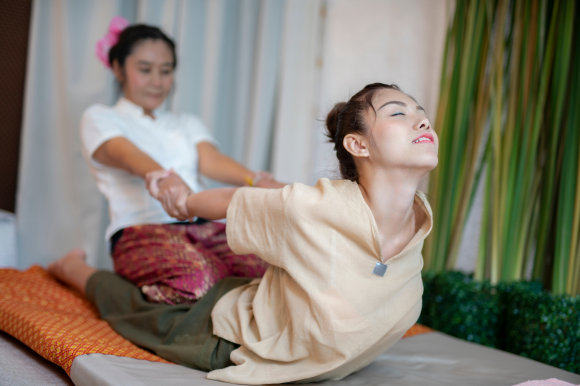How to Experience a Traditional Thai Massage for Muscle Recovery
Luke Iles – Uploaded 06.08.2025


A Traveller’s Guide to Traditional Thai Massage Healing After Intense Training
If you’ve been putting your body through the paces in Bangkok – whether it’s CrossFit, Muay Thai, or long days exploring – a traditional Thai massage is more than just relaxation.
It’s a powerful method of muscle recovery grounded in centuries-old healing practices. In this guide, I’ll show you exactly how to experience a traditional Thai massage for muscle recovery, including where to go, what to expect, and how it benefits both your body and mind.
TL;DR – Quick Summary
- Thai massage helps improve blood flow, relieve muscle tension, and speed up the healing process.
- Expect a mix of assisted stretching, deep tissue massage, and rhythmic compression along the body’s energy lines.
- Great for treating sore or injured muscles, improving range of motion, and supporting mental well-being.
- Avoid cheap tourist spas. Instead, choose places with skilled therapists trained in traditional Thai techniques.
- Refuel after your session at best organic restaurants in Bangkok or grab a recovery-friendly meal from where to find healthy meal prep services in Bangkok.
Why Thai Massage Is Perfect for Muscle Recovery
Unlike a Swedish massage which uses smooth strokes and oil, a traditional Thai massage involves applying pressure, assisted stretching, and working along your body’s energy pathways.
Many people choose Thai massage because of its holistic approach, which not only targets muscle recovery but also supports relaxation, rejuvenation, and overall well-being.
Thai massage works on the entire body, using movement and stretching to promote overall wellness and recovery. It is incredibly effective for balancing the body’s energy lines and body’s energy pathways, which are essential for maintaining health, vitality, and muscle recovery.
It’s incredibly effective for:
- Releasing muscle tension after training
- Reducing inflammation and easing chronic pain
- Supporting injury prevention and promoting joint mobility
- Enhancing blood circulation and stimulating lymphatic drainage
- Balancing energy lines for overall well-being
- Involves stretching as a key technique to improve flexibility and mobility
- Improved circulation, which aids in muscle recovery and flexibility
- Improving circulation, helping to alleviate muscle tension and pain
Having experienced Thai massage weekly while training Muay Thai, I noticed a major improvement in my range of motion and muscle relaxation.
What a Traditional Thai Massage Session Is Really Like
A real Thai massage experience isn’t always gentle – especially if you’re going for muscle tension release.
Here’s what you can expect:
Element | What Happens |
Clothing | You stay clothed in loose garments provided by the spa |
Technique | Uses firm pressure, deep stretching, and gentle rocking |
Focus Areas | Targets specific pressure points and energy flow pathways |
Benefits | Immediate pain relief, enhanced blood flow, and muscle looseness |
The techniques used in Thai massage help relieve tension and are highly effective at relieving tension in tight muscles.
Thai massage promotes relaxation and is especially effective for promoting relaxation after intense activity. It is also known for reducing stress and providing significant stress relief, making it a top choice for both physical and mental recovery.
Many spas primarily focus on full-body recovery, while others offer sports massage or deep tissue alternatives. Be clear with the therapist about any injured muscles or areas of muscle stiffness.
Where to Get a Legit Thai Massage in Bangkok
Avoid neon-lit tourist traps that push for “cheap deals.”
For authentic recovery benefits, head to spas with trained professionals.
Here are a few personal favourites:
- Health Land Spa & Massage – Large, clean, and consistent quality across locations.
- Wat Pho Thai Traditional Massage School – A heritage institution offering massages in the birthplace of Thai massage.
- Perception Blind Massage – Unique experience with visually impaired therapists trained in deep tissue massage and pain relief.
After your session, consider cooling down with a tea at one of the best coffee shops in Bangkok or unwind at a floating restaurant with a riverside view.
Thai Massage Techniques That Support Recovery
Here are some key techniques your therapist may use:
- Deep tissue kneading to loosen muscle cells
- Gentle stretching that mirrors yoga-like postures
- Rhythmic compression to stimulate blood vessels
- Targeted pressure on tight shoulders, back, and legs
Thai massage can also help with neck pain and poor posture, especially for those with sedentary lifestyles or who spend long hours at a desk.
These techniques are rooted in Thai culture and provide numerous benefits beyond just easing sore muscles – they contribute to mental clarity, spiritual well-being, and a greater sense of overall well-being.
Thai massage supports maintaining health by balancing the body’s energy and supporting long-term vitality.
Best Times to Get a Thai Massage for Recovery
- After intense workouts or sports sessions
- On rest days during your training cycle
- During long layovers or travel fatigue days
If you’ve just trained at a best Muay Thai gym in Bangkok, or pushed through a CrossFit session, booking a massage after can make a massive difference to your healing process.
Complement Your Recovery with Bangkok Wellness
- Explore nature: Visit the best places to visit on the Andaman Coast for a beach escape.
- Eat clean: Try best Thai hot pot in Bangkok or how to eat like a local in Bangkok.
- Stretch further: Join a session at best yoga spots in Bangkok or explore best rock climbing gyms in Bangkok.
Introduction to Thai Massage
Thai massage is an ancient healing art that has been practiced in Thailand for over 2,500 years. Rooted in a holistic approach to wellness, Thai massage combines elements of yoga, acupressure, and deep tissue massage to promote relaxation, relieve muscle tension, and support overall well-being.
By applying pressure to specific points along the body’s energy lines—known as Sen lines—Thai massage helps restore balance and vitality to both body and mind. Whether you’re dealing with chronic pain, everyday stress, or simply want to enhance your health, Thai massage offers numerous benefits.
This deep tissue technique is designed not only to ease physical discomfort but also to improve your energy flow, making it a powerful tool for anyone seeking a natural path to better health and well-being.
Preparing for Your Thai Massage Journey
Before you step into your first Thai massage session, a little preparation goes a long way. Wear loose, comfortable clothing that allows for easy movement, as you’ll remain fully clothed throughout the massage.
Arrive at least 15 minutes early to give yourself time to relax and fill out any necessary forms. It’s important to communicate openly with your therapist about any areas of muscle tension, pain, or health concerns you may have—this ensures your Thai massage is tailored to your needs. Staying hydrated before and after your session will help your body flush out toxins and support the healing process.
With these simple steps, you’ll be ready to make the most of your Thai massage experience.
The Massage Experience: Step by Step
A traditional Thai massage begins with you lying comfortably on a padded mat, dressed in loose clothing provided by the spa.
Your therapist will guide you through a series of gentle rocking motions, deep stretching, and rhythmic compression, focusing on specific points along your body’s energy lines. Using hands, feet, elbows, and knees, the therapist will apply pressure and move your body into yoga-like postures designed to release tension and improve circulation.
Throughout the session, you may experience joint mobilization and techniques that encourage lymphatic drainage, all working together to promote relaxation and enhance your overall sense of well-being. Each step is carefully crafted to help your body recover, leaving you feeling refreshed and restored.
Key Techniques and Principles
At the heart of Thai massage are several key techniques and principles that set it apart from other forms of massage therapy.
Therapists use targeted pressure along the body’s energy lines to address muscle tension and encourage energy balance.
Deep stretching is incorporated to improve flexibility and range of motion, while rhythmic compression helps promote relaxation and reduce tightness. Gentle rocking and assisted stretching further support joint mobility and release tension throughout the body. By blending these methods, Thai massage takes a holistic approach to health, supporting both your physical and energetic well-being and helping you achieve a greater sense of overall vitality.
Post-Massage Care for Optimal Recovery
To get the most out of your Thai massage, it’s important to care for your body after the session. Drink plenty of water to stay hydrated and help your muscles recover.
Avoid strenuous activities for the rest of the day, giving your body time to rest and absorb the benefits of the massage. Gentle stretching can help maintain your improved range of motion and keep your muscles flexible.
If you notice any lingering areas of tension, applying a warm compress can provide additional relief. By following these simple post-massage tips, you’ll extend the positive effects of your Thai massage and support your ongoing recovery.
Precautions and Contraindications
While Thai massage is generally safe and beneficial, there are some situations where extra caution is needed.
If you are pregnant, have recently undergone surgery, or have medical conditions such as osteoporosis, high blood pressure, or heart disease, it’s essential to consult your healthcare provider before booking a Thai massage.
Always inform your therapist about any injuries, discomfort, or health concerns so they can adjust their techniques accordingly. Open communication ensures your Thai massage experience is both safe and effective, allowing you to enjoy all the benefits while minimizing any risks.
Conclusion: Rebuild Your Body with Thai Massage
Now that you know how to experience a traditional Thai massage for muscle recovery, don’t treat it like a tourist novelty.
It’s one of the most powerful recovery tools in Thailand – improving blood circulation, muscle relaxation, and your overall well-being in just one session.
For serious athletes or active travellers, integrating Thai massage into your recovery routine can help you stay energised, reduce inflammation, and perform at your best.
Read Travel Blogs & More
Disclosure: Some links in this article may be affiliate links, which can provide compensation to HandL Blogs at no cost to you if you decide to purchase through these links. These are products we have personally used and stand behind. This site is not intended to provide financial advice and is for entertainment only. You can read our affiliate disclosure in our privacy policy.

Luke Iles
Luke is a leading travel writer within the travel niche and is also a co-founder of HandL Blogs one of the UK’s leading travel blogging websites. Luke has a love of all things travel.
Initially becoming friends with his other co-founder, Harry, at the age of four years old, they let their love for travel evolve, making it their mission to visit every country in the world!
Today they want to share their passion and experiences of travelling across the globe with written blogs on topics that are most important to them. From travel, cooking, fitness and tech blogs!
Whether that be trying new food in a new country and sharing it in a cooking blog; visiting a new gym in a certain city and reviewing it in a fitness blog or learning about the newest tech within the travel industry.
Disclosure: Some links in this article may be affiliate links, which can provide compensation to HandL Blogs at no cost to you if you decide to purchase through these links. These are products we have personally used and stand behind. This site is not intended to provide financial advice and is for entertainment only. You can read our affiliate disclosure in our privacy policy.
